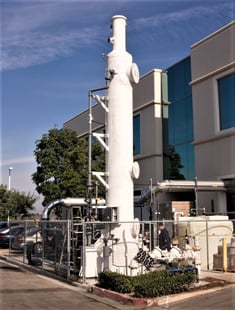Regenerative thermal oxidizer’s (RTO’s) are thermally efficient devices used to destroy low concentrations of volatile organic compounds (VOC’s). Chlorinated compounds, if present, oxidize into hydrochloric acid (HCl) which must be removed after the RTO.
removed after the RTO.
Two examples are Carestream Health in Rochester, NY, a health care products supplier, and Illumina in San Diego, CA, a biotechnology provider. Facilities at both companies generate low concentrations of chlorinated VOC’s. Control devices are needed to remove HCl emissions downstream of RTO’s used to meet VOC emissions.
Envitech packed bed absorbers were selected to treat the RTO exhaust gases. The first step in the scrubbing process is an evaporative quencher to cool the gas to saturation. A horizontal quencher simplifies ductwork and installation cost. Al6XN construction provides corrosion resistance.es are Carestream Health in Rochester, NY, a health care products supplier, and Illumina in San Diego, CA, a biotechnology provider. Facilities at both companies generate low concentrations of chlorinated VOC’s. Control devices are needed to remove HCl emissions downstream of RTO’s used to meet VOC emissions.Envitech packed bed absorbers were selected to treat the RTO exhaust gases. The first step in the scrubbing process is an evaporative quencher to cool the gas to saturation. A horizontal quencher simplifies ductwork and installation cost. Al6XN construction provides corrosion resistance.
The quencher is followed by a fiber reinforced plastic (FRP) vertical packed bed absorber with gas flowing vertically upward, counter current to downward flowing water. Excess water from the quencher and packed bed collects in the absorber sump and recirculates to the quencher and packed bed. A dilute caustic solution (NaOH) is injected into the discharge side of the recirculation pump to neutralize HCl. A blowdown stream purges the system of reaction products. Caustic injection and blowdown are controlled by pH and oxidation reduction potential (ORP).
Gaseous HCl readily absorbs into the scrubber recirculation liquid. A fraction of the HCl forms a submicron aerosol as gas contacts water in the quencher to cool the gas. The aerosol is removed by a properly designed mist eliminator. Gas calculations are used to estimate the fraction of acid aerosol based on gas dew point and partial pressures of water and acid. The mist eliminator must be capable of removing aerosol at the expected concentration and droplet size distribution. This impacts the mist eliminator selection, vessel size, and pressure drop of the system.
The scrubbers were put into service and effectively operate on a continuous basis with minimal operator management. Operating parameters and performances are summarized below.
| Design | Carestream, NY | Illumina, CA |
| Flow, acfm | 6,000 | 4,000 |
| Inlet Temp, oF | 585 | 230 |
| Inlet HCl, lb/hr | 92 | 10 |
| HCl Removal Efficiency, % | 99 | 99 |
Click on the link below to download literature about this application.


